Hoffman D.M., Singh B., Thomas J.H. (Eds). Handbook of Vacuum Science and Technology
Подождите немного. Документ загружается.

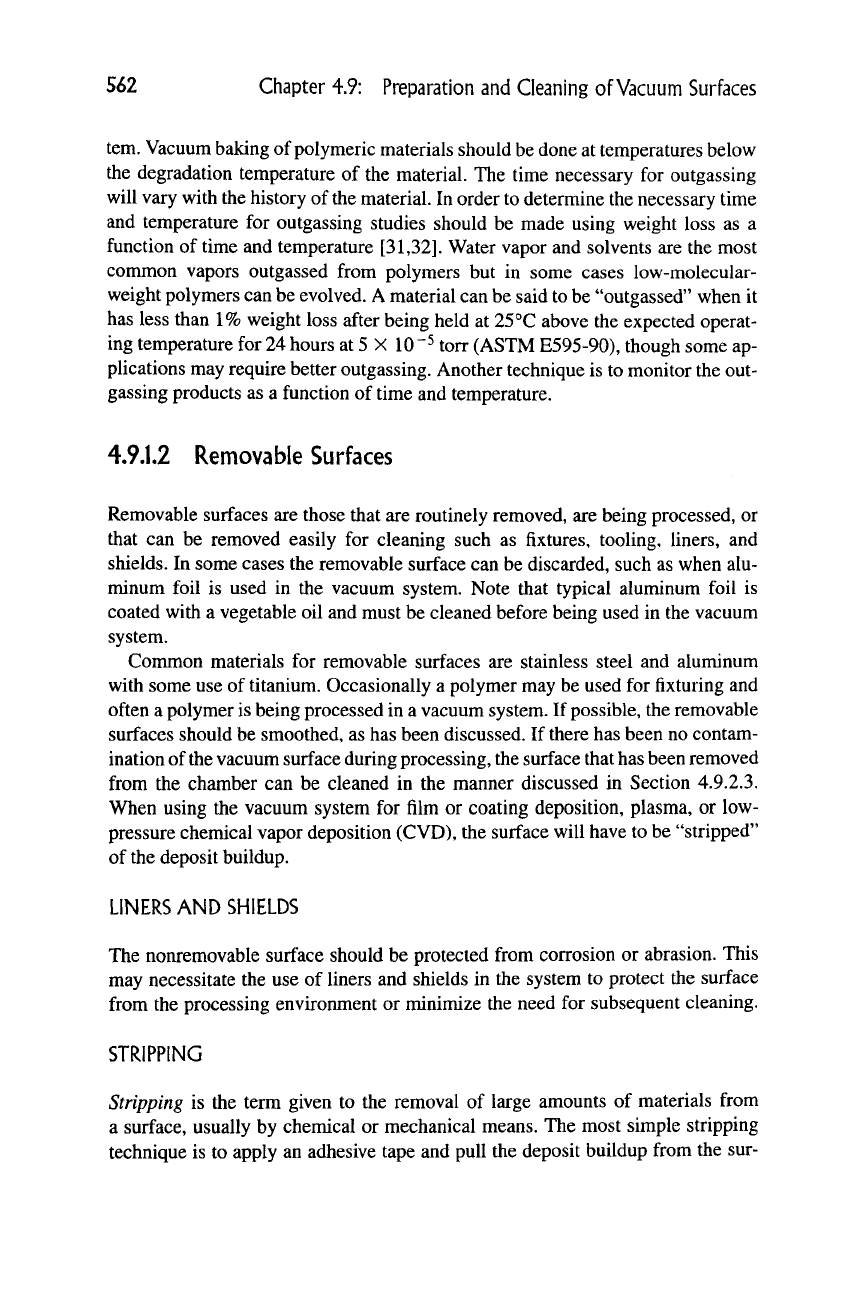
562 Chapter 4.9: Preparation
and
Cleaning of Vacuum Surfaces
tern. Vacuum baking of polymeric materials should be done at temperatures below
the degradation temperature of the material. The time necessary for outgassing
will vary with the history of the material. In order to determine the necessary time
and temperature for outgassing studies should be made using weight loss as a
function of time and temperature [31,32]. Water vapor and solvents are the most
common vapors outgassed from polymers but in some cases low-molecular-
weight polymers can be evolved. A material can be said to be "outgassed" when it
has less than 1% weight loss after being held at 25 °C above the expected operat-
ing temperature for 24 hours at 5 X 10"^ torr (ASTM E595-90), though some ap-
plications may require better outgassing. Another technique is to monitor the out-
gassing products as a function of time and temperature.
4.9.1.2 Removable Surfaces
Removable surfaces are those that are routinely removed, are being processed, or
that can be removed easily for cleaning such as fixtures, tooling, liners, and
shields. In some cases the removable surface can be discarded, such as when alu-
minum foil is used in the vacuum system. Note that typical aluminum foil is
coated with a vegetable oil and must be cleaned before being used in the vacuum
system.
Common materials for removable surfaces are stainless steel and aluminum
with some use of titanium. Occasionally a polymer may be used for fixturing and
often a polymer is being processed in a vacuum system. If
possible,
the removable
surfaces should be smoothed, as has been discussed. If there has been no contam-
ination of the vacuum surface during processing, the surface that
has
been removed
from the chamber can be cleaned in the manner discussed in Section 4.9.2.3.
When using the vacuum system for film or coating deposition, plasma, or low-
pressure chemical vapor deposition (CVD), the surface will have to be "stripped"
of the deposit buildup.
LINERS AND SHIELDS
The nonremovable surface should be protected from corrosion or abrasion. This
may necessitate the use of liners and shields in the system to protect the surface
from the processing environment or minimize the need for subsequent cleaning.
STRIPPING
Stripping is the term given to the removal of large amounts of materials from
a surface, usually by chemical or mechanical means. The most simple stripping
technique is to apply an adhesive tape and pull the deposit buildup from the sur-
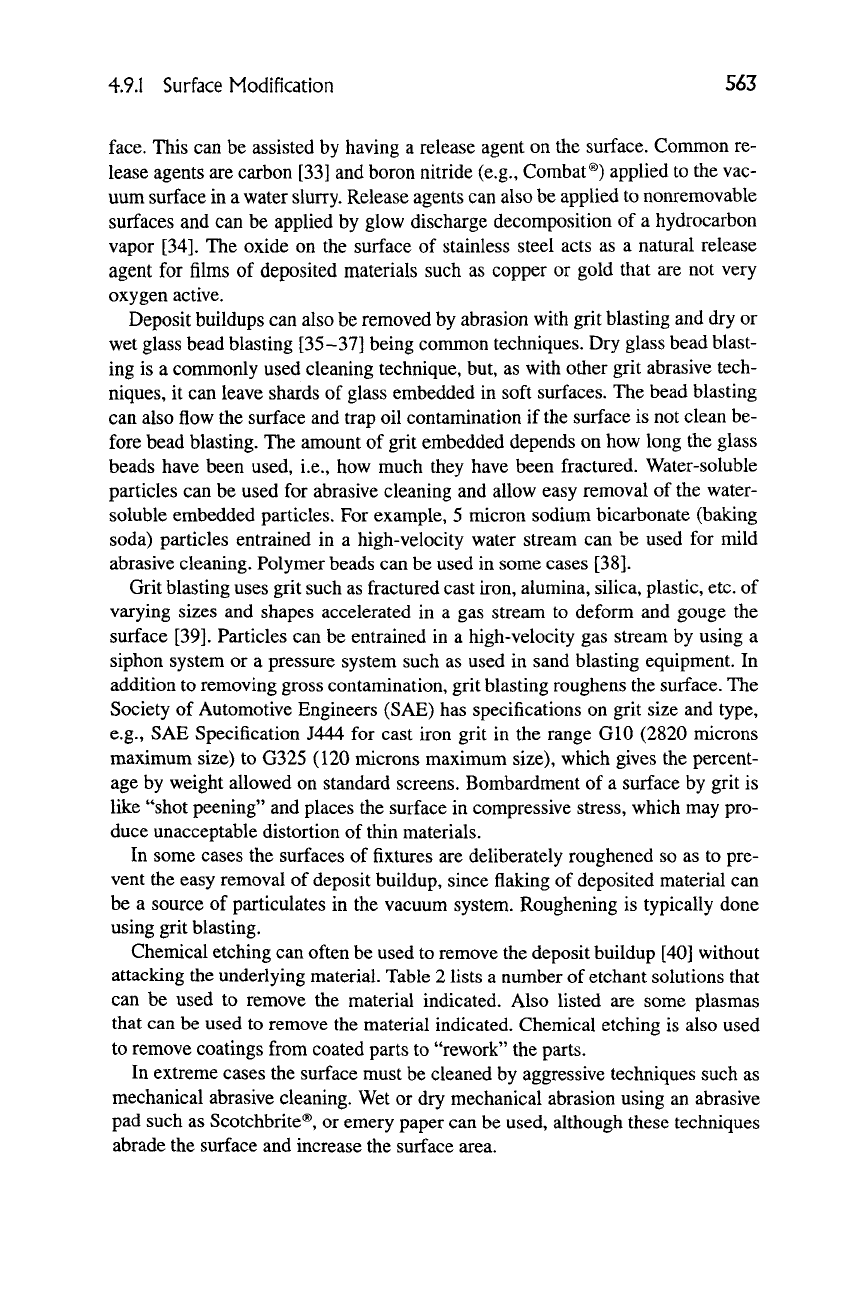
4.9.1 Surface Modification 563
face.
This can be assisted by having a release agent on the surface. Common re-
lease agents are carbon [33] and boron nitride (e.g.. Combat®) applied to the vac-
uum surface in a water slurry. Release agents can also be applied to nonremovable
surfaces and can be applied by glow discharge decomposition of a hydrocarbon
vapor [34]. The oxide on the surface of stainless steel acts as a natural release
agent for films of deposited materials such as copper or gold that are not very
oxygen active.
Deposit buildups can also be removed by abrasion with grit blasting and dry or
wet glass bead blasting [35-37] being common techniques. Dry glass bead blast-
ing is a commonly used cleaning technique, but, as with other grit abrasive tech-
niques, it can leave shards of glass embedded in soft surfaces. The bead blasting
can also flow the surface and trap oil contamination if the surface is not clean be-
fore bead blasting. The amount of grit embedded depends on how long the glass
beads have been used, i.e., how much they have been fractured. Water-soluble
particles can be used for abrasive cleaning and allow easy removal of the water-
soluble embedded particles. For example, 5 micron sodium bicarbonate (baking
soda) particles entrained in a high-velocity water stream can be used for mild
abrasive cleaning. Polymer beads can be used in some cases [38].
Grit blasting uses grit such as fractured cast iron, alumina, silica, plastic, etc. of
varying sizes and shapes accelerated in a gas stream to deform and gouge the
surface [39]. Particles can be entrained in a high-velocity gas stream by using a
siphon system or a pressure system such as used in sand blasting equipment. In
addition to removing gross contamination, grit blasting roughens the surface. The
Society of Automotive Engineers (SAE) has specifications on grit size and type,
e.g., SAE Specification J444 for cast iron grit in the range GIO (2820 microns
maximum size) to G325 (120 microns maximum size), which gives the percent-
age by weight allowed on standard screens. Bombardment of a surface by grit is
like "shot peening" and places the surface in compressive stress, which may pro-
duce unacceptable distortion of thin materials.
In some cases the surfaces of fixtures are deliberately roughened so as to pre-
vent the easy removal of deposit buildup, since flaking of deposited material can
be a source of particulates in the vacuum system. Roughening is typically done
using grit blasting.
Chemical etching can often be used to remove the deposit buildup [40] without
attacking the underlying material. Table 2 lists a number of etchant solutions that
can be used to remove the material indicated. Also listed are some plasmas
that can be used to remove the material indicated. Chemical etching is also used
to remove coatings from coated parts to "rework" the parts.
In extreme cases the surface must be cleaned by aggressive techniques such as
mechanical abrasive cleaning. Wet or dry mechanical abrasion using an abrasive
pad such as Scotchbrite®, or emery paper can be used, although these techniques
abrade the surface and increase the surface area.
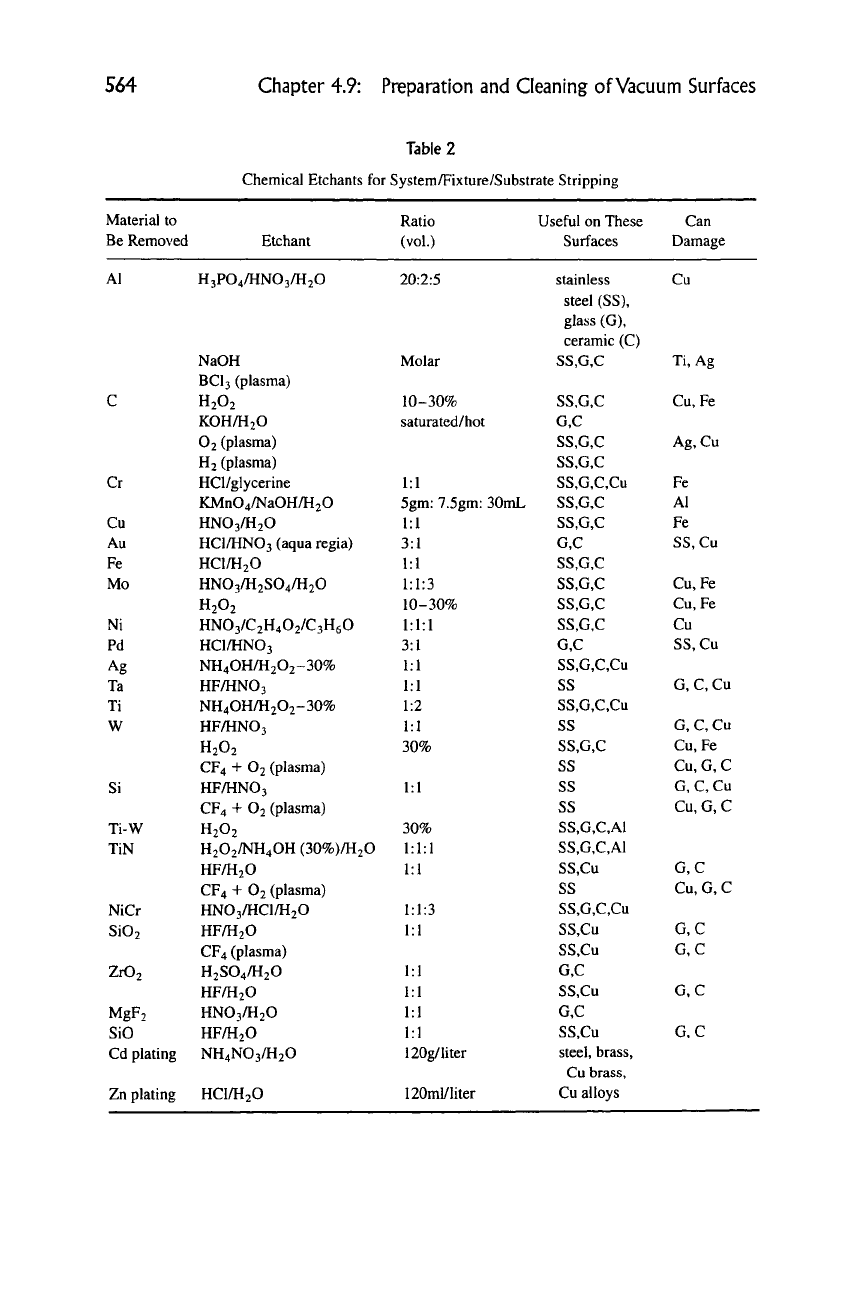
564
Chapter
4.9:
Preparation
and
Cleaning
of
Vacuum Surfaces
Table
2
Chemical Etchants
for
System/Fixture/Substrate Stripping
Material
to
Be
Removed
Al
C
Cr
Cu
Au
Fe
Mo
Ni
Pd
Ag
Ta
Ti
W
Si
Ti-W
TiN
NiCr
Si02
Zr02
MgF2
SiO
Cd
plating
Zn
plating
Etchant
H3PO4/HNO3/H2O
NaOH
BCI3 (plasma)
H2O2
KOH/H2O
O2
(plasma)
H2
(plasma)
HCl/glycerine
KMn04/NaOH/H20
HNO3/H2O
HCI/HNO3 (aqua regia)
HCI/H2O
HNO3/H2SO4/H2O
H2O2
HNO3/C2H4O2/C3H6O
HCI/HNO3
NH4OH/H2O2-30%
HF/HNO3
NH4OH/H2O2-30%
HF/HNO3
H2O2
CF4 + O2
(plasma)
HF/HNO3
CF4 + O2
(plasma)
H2O2
H2O2/NH4OH (30%)/H2O
HF/H2O
CF4 + O2
(plasma)
HNO3/HCI/H2O
HF/H2O
CF4
(plasma)
H2SO4/H2O
HF/H2O
HNO3/H2O
HF/H2O
NH4NO3/H2O
HCI/H2O
Ratio
(vol.)
20:2:5
Molar
10-30%
saturated/hot
1:1
5gm:
7.5gm:
30mL
1:1
3:1
1:1
1:1:3
10-30%
1:1:1
3:1
1:1
1:1
1:2
1:1
30%
1:1
30%
1:1:1
1:1
1:1:3
1:1
1:1
1:1
1:1
1:1
120g/liter
120ml/liter
Useful
on
These
Surfaces
stainless
steel
(SS),
glass
(G),
ceramic
(C)
SS,G,C
SS,G,C
G,C
SS,G,C
SS,G,C
SS,G,C,Cu
SS,G,C
SS,G,C
G,C
SS,G,C
SS,G,C
SS,G,C
SS,G,C
G,C
SS,G,C,Cu
SS
SS,G,C,Cu
SS
SS,G,C
SS
SS
SS
SS,G,C,A1
SS,G,C,A1
SS,Cu
SS
SS,G,C,Cu
SS,Cu
SS,Cu
G,C
SS,Cu
G,C
SS,Cu
steel,
brass,
Cu brass.
Cu
alloys
Can
Damage
Cu
Ti,Ag
Cu,Fe
Ag,Cu
Fe
Al
Fe
SS,Cu
Cu,Fe
Cu,Fe
Cu
SS,Cu
G,
C,
Cu
G,
C,
Cu
Cu,Fe
Cu,
G, C
G,
C,
Cu
Cu,
G, C
G,C
Cu,
G, C
G,C
G,C
G.C
G,C
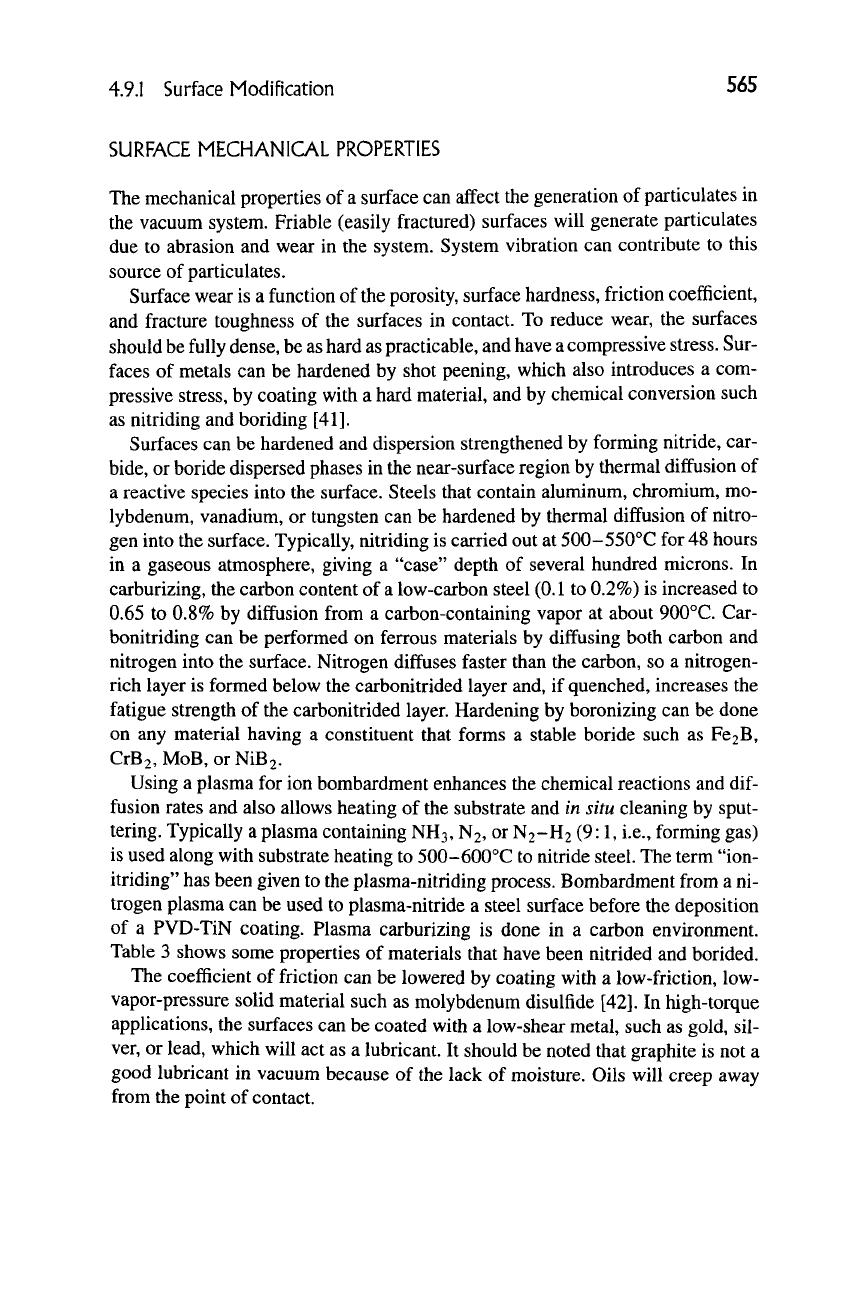
4.9.1 Surface Modification 565
SURFACE MECHANICAL PROPERTIES
The mechanical properties of a surface can affect the generation of particulates in
the vacuum system. Friable (easily fractured) surfaces will generate particulates
due to abrasion and wear in the system. System vibration can contribute to this
source of particulates.
Surface wear is a function of the porosity, surface hardness, friction coefficient,
and fracture toughness of the surfaces in contact. To reduce wear, the surfaces
should be fully dense, be as hard as practicable, and have
a
compressive
stress.
Sur-
faces of metals can be hardened by shot peening, which also introduces a com-
pressive stress, by coating with a hard material, and by chemical conversion such
as nitriding and bonding [41].
Surfaces can be hardened and dispersion strengthened by forming nitride, car-
bide,
or boride dispersed phases in the near-surface region by thermal diffusion of
a reactive species into the surface. Steels that contain aluminum, chromium, mo-
lybdenum, vanadium, or tungsten can be hardened by thermal diffusion of nitro-
gen into the surface. Typically, nitriding is carried out at 500-550°C for 48 hours
in a gaseous atmosphere, giving a "case" depth of several hundred microns. In
carburizing, the carbon content of a low-carbon steel (0.1 to 0.2%) is increased to
0.65 to 0.8% by diffusion from a carbon-containing vapor at about 900°C. Car-
bonitriding can be performed on ferrous materials by diffusing both carbon and
nitrogen into the surface. Nitrogen diffuses faster than the carbon, so a nitrogen-
rich layer is formed below the carbonitrided layer and, if quenched, increases the
fatigue strength of the carbonitrided layer. Hardening by boronizing can be done
on any material having a constituent that forms a stable boride such as Fe2B,
CrB2,
MoB, orNiB2.
Using a plasma for ion bombardment enhances the chemical reactions and
dif-
fusion rates and also allows heating of the substrate and in situ cleaning by sput-
tering. Typically a plasma containing NH3, N2, or N2-H2
(9:1,
i.e., forming gas)
is used along with substrate heating to 500-600°C to nitride steel. The term "ion-
itriding" has been given to the plasma-nitriding process. Bombardment from a ni-
trogen plasma can be used to plasma-nitride a steel surface before the deposition
of a PVD-TiN coating. Plasma carburizing is done in a carbon environment.
Table 3 shows some properties of materials that have been nitrided and borided.
The coefficient of friction can be lowered by coating with a low-friction, low-
vapor-pressure solid material such as molybdenum disulfide [42]. In high-torque
applications, the surfaces can be coated with a low-shear metal, such as gold, sil-
ver, or lead, which will act as a lubricant. It should be noted that graphite is not a
good lubricant in vacuum because of the lack of moisture. Oils will creep away
from the point of contact.
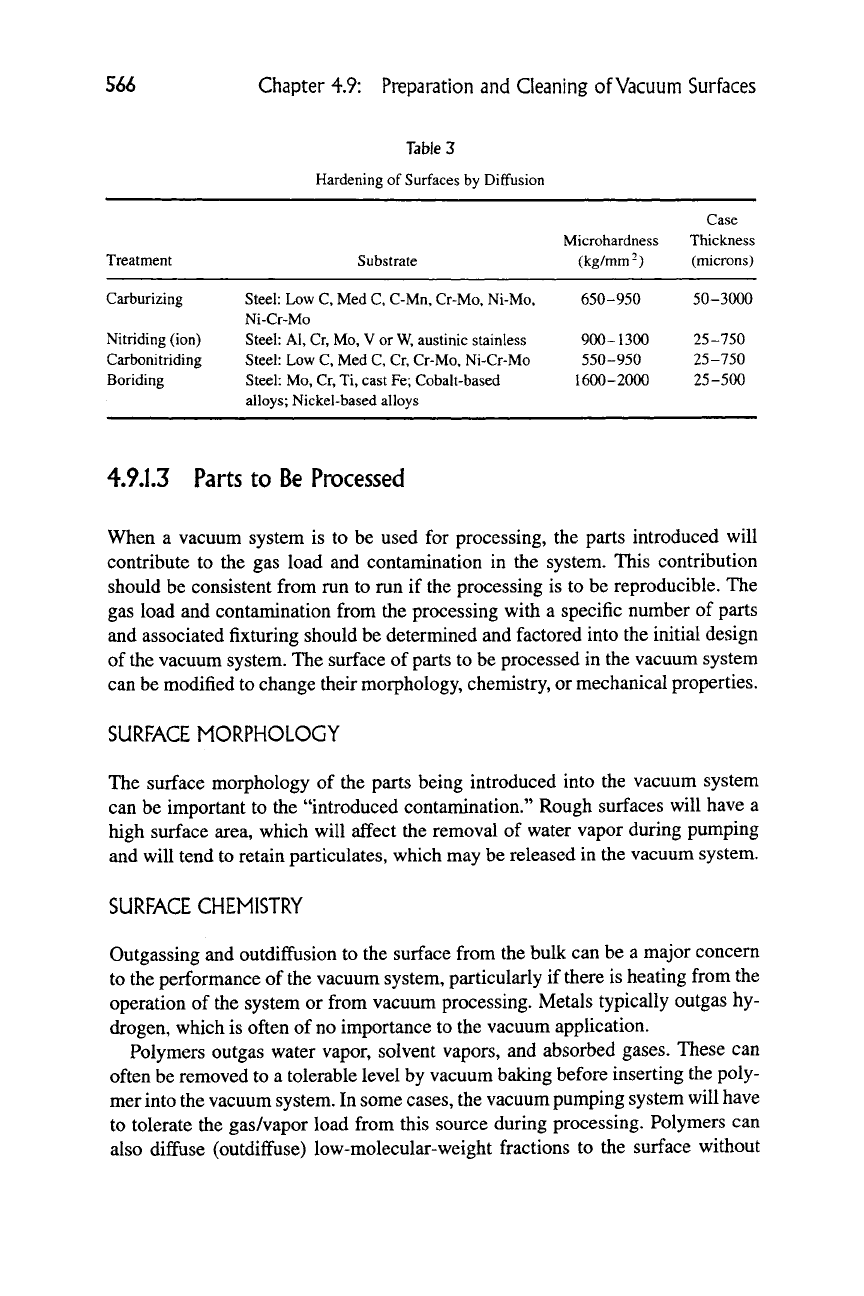
566 Chapter 4.9: Preparation and Cleaning of Vacuum Surfaces
Table 3
Hardening of Surfaces by Diffusion
Treatment
Carburizing
Nitriding (ion)
Carbonitriding
Bonding
Substrate
Steel: Low C, Med C, C-Mn, Cr-Mo, Ni-Mo,
Ni-Cr-Mo
Steel: Al, Cr, Mo, V or
W,
austinic stainless
Steel: Low C, Med C, Cr, Cr-Mo, Ni-Cr-Mo
Steel: Mo, Cr, Ti, cast Fe; Cobalt-based
alloys; Nickel-based alloys
Microhardness
(kg/mm-)
650-950
900-1300
550-950
1600-2000
Case
Thickness
(microns)
50-3000
25-750
25-750
25-500
4.9.1.3 Parts to Be Processed
When a vacuum system is to be used for processing, the parts introduced will
contribute to the gas load and contamination in the system. This contribution
should be consistent from run to run if the processing is to be reproducible. The
gas load and contamination from the processing with a specific number of parts
and associated fixturing should be determined and factored into the initial design
of the vacuum system. The surface of parts to be processed in the vacuum system
can be modified to change their morphology, chemistry, or mechanical properties.
SURFACE MORPHOLOGY
The surface morphology of the parts being introduced into the vacuum system
can be important to the "introduced contamination." Rough surfaces will have a
high surface area, which will affect the removal of water vapor during pumping
and will tend to retain particulates, which may be released in the vacuum system.
SURFACE CHEMISTRY
Outgassing and outdiffusion to the surface from the bulk can be a major concern
to the performance of the vacuum system, particularly if there is heating from the
operation of the system or from vacuum processing. Metals typically outgas hy-
drogen, which is often of no importance to the vacuum application.
Polymers outgas water vapor, solvent vapors, and absorbed gases. These can
often be removed to a tolerable level by vacuum baking before inserting the poly-
mer into the vacuum system. In some cases, the vacuum pumping system will have
to tolerate the gas/vapor load from this source during processing. Polymers can
also diffuse (outdififuse) low-molecular-weight fractions to the surface without
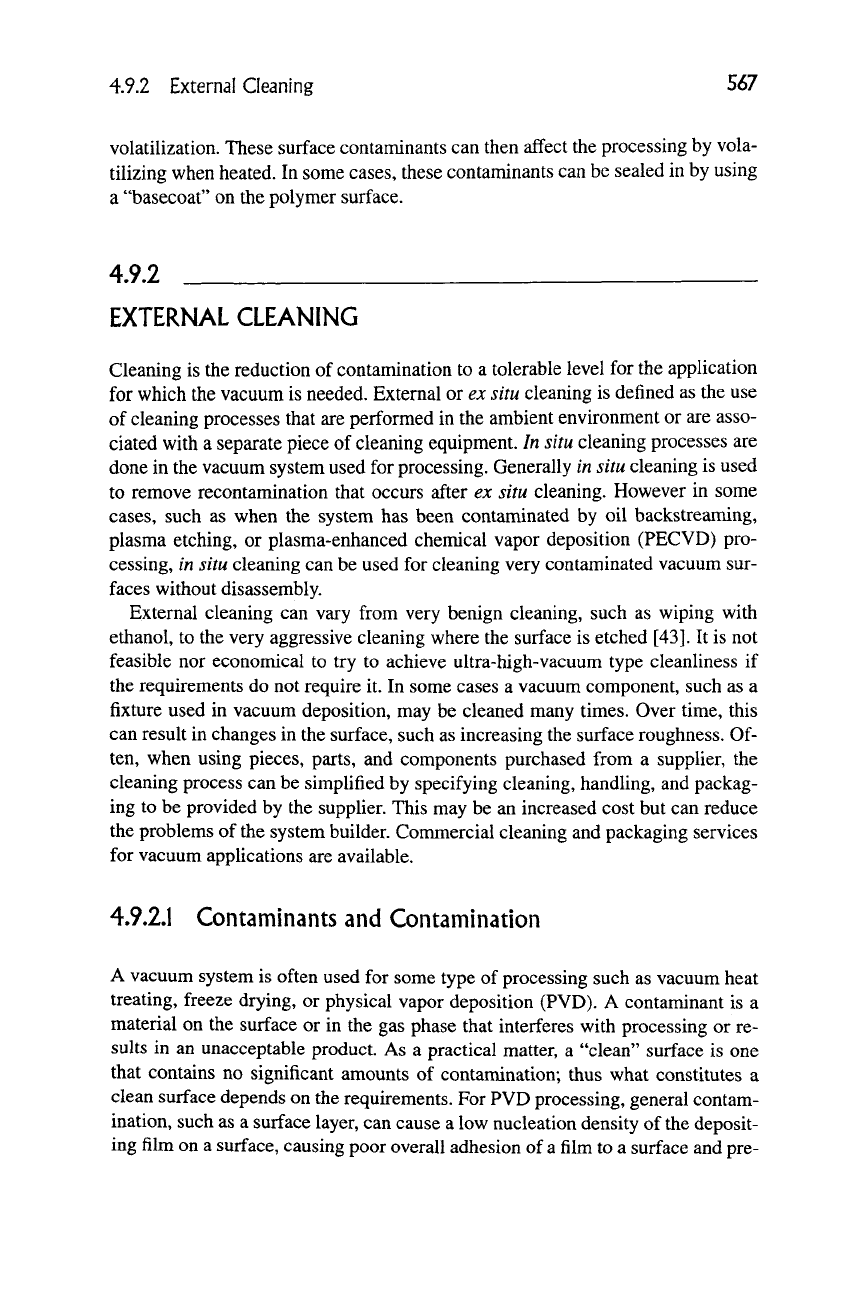
4.9.2 External Cleaning 567
volatilization. These surface contaminants can then affect the processing by vola-
tilizing when heated. In some cases, these contaminants can be sealed in by using
a "basecoat" on the polymer surface.
4.9.2
EXTERNAL CLEANING
Cleaning is the reduction of contamination to a tolerable level for the application
for which the vacuum is needed. External or ex situ cleaning is defined as the use
of cleaning processes that are performed in the ambient environment or are asso-
ciated with a separate piece of cleaning equipment. In situ cleaning processes are
done in the vacuum system used for processing. Generally in situ cleaning is used
to remove recontamination that occurs after ex situ cleaning. However in some
cases,
such as when the system has been contaminated by oil backstreaming,
plasma etching, or plasma-enhanced chemical vapor deposition (PECVD) pro-
cessing, in situ cleaning can be used for cleaning very contaminated vacuum sur-
faces without disassembly.
External cleaning can vary from very benign cleaning, such as wiping with
ethanol, to the very aggressive cleaning where the surface is etched [43]. It is not
feasible nor economical to try to achieve ultra-high-vacuum type cleanliness if
the requirements do not require it. In some cases a vacuum component, such as a
fixture used in vacuum deposition, may be cleaned many times. Over time, this
can result in changes in the surface, such as increasing the surface roughness. Of-
ten, when using pieces, parts, and components purchased from a supplier, the
cleaning process can be simplified by specifying cleaning, handling, and packag-
ing to be provided by the supplier. This may be an increased cost but can reduce
the problems of the system builder. Commercial cleaning and packaging services
for vacuum applications are available.
4.9.2.1 Contaminants and Contamination
A vacuum system is often used for some type of processing such as vacuum heat
treating, freeze drying, or physical vapor deposition (PVD). A contaminant is a
material on the surface or in the gas phase that interferes with processing or re-
sults in an unacceptable product. As a practical matter, a "clean" surface is one
that contains no significant amounts of contamination; thus what constitutes a
clean surface depends on the requirements. For PVD processing, general contam-
ination, such as a surface layer, can cause a low nucleation density of the deposit-
ing film on a surface, causing poor overall adhesion of
a
film to a surface and pre-
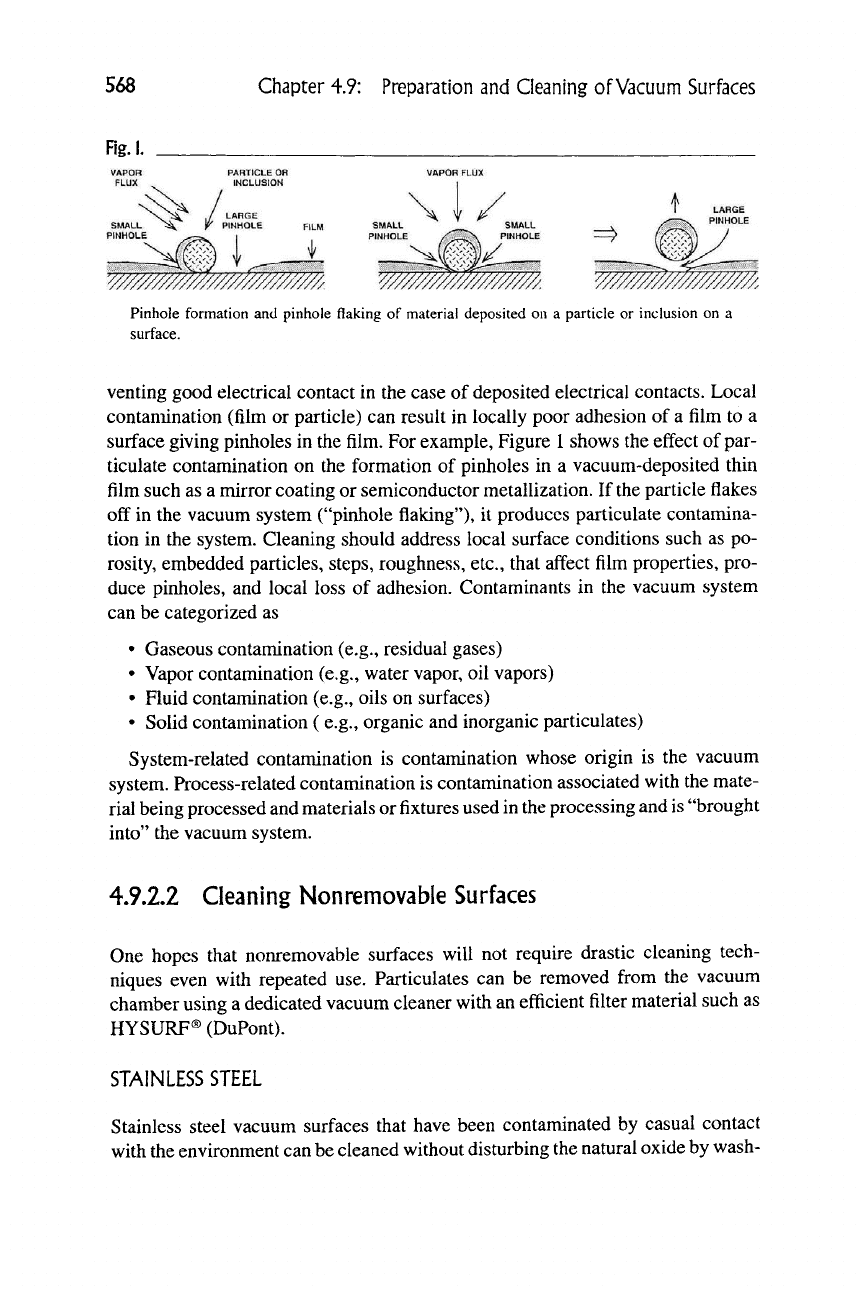
568
Chapter 4.9: Preparation and Cleaning of Vacuum Surfaces
Rg.l.
VAPOR
FLUX
PARTICLE OR
INCLUSION
VAPOR FLUX
,/ LARGE
SMALL >^^ |K PINHOLE
PINHOLE
Pinhole formation and pinhole flaking of material deposited on a particle or inclusion on a
surface.
venting good electrical contact in the case of deposited electrical contacts. Local
contamination (film or particle) can result in locally poor adhesion of a film to a
surface giving pinholes in the film. For example, Figure
1
shows the effect of par-
ticulate contamination on the formation of pinholes in a vacuum-deposited thin
film such as a mirror coating or semiconductor metallization. If the particle flakes
off in the vacuum system ("pinhole flaking"), it produces particulate contamina-
tion in the system. Cleaning should address local surface conditions such as po-
rosity, embedded particles, steps, roughness, etc., that affect film properties, pro-
duce pinholes, and local loss of adhesion. Contaminants in the vacuum system
can be categorized as
• Gaseous contamination (e.g., residual gases)
• Vapor contamination (e.g., water vapor, oil vapors)
• Fluid contamination (e.g., oils on surfaces)
• Solid contamination ( e.g., organic and inorganic particulates)
System-related contamination is contamination whose origin is the vacuum
system. Process-related contamination is contamination associated with the mate-
rial being processed and materials or
fixtures
used in the processing and
is
"brought
into"
the vacuum system.
4,9.2.2 Cleaning Nonremovable Surfaces
One hopes that nonremovable surfaces will not require drastic cleaning tech-
niques even with repeated use. Particulates can be removed from the vacuum
chamber using a dedicated vacuum cleaner with an efficient filter material such as
HYSURF® (DuPont).
STAINLESS STEEL
Stainless steel vacuum surfaces that have been contaminated by casual contact
with the environment can be cleaned without disturbing the natural oxide by wash-
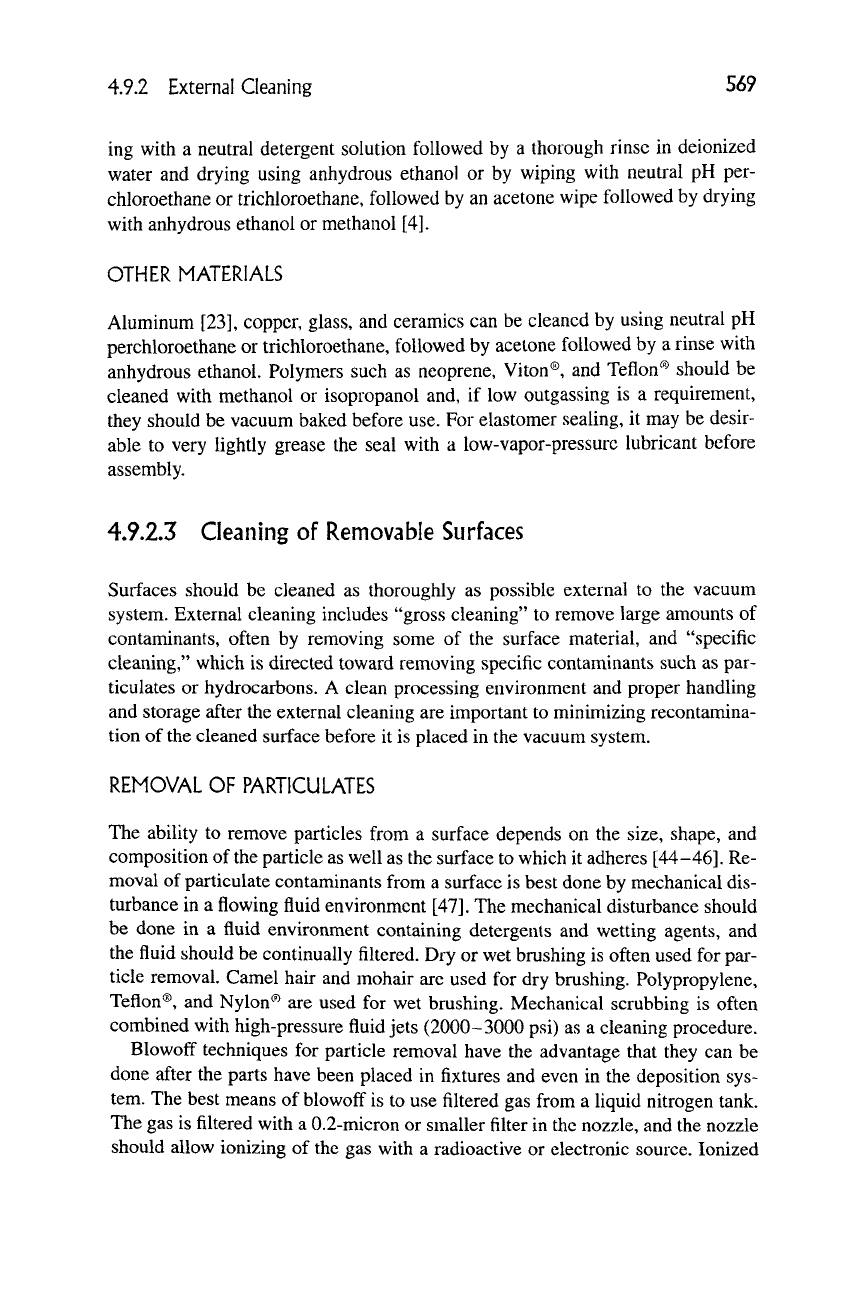
4.9.2 External Cleaning 569
ing with a neutral detergent solution followed by a thorough rinse in deionized
water and drying using anhydrous ethanol or by wiping with neutral pH per-
chloroethane or trichloroethane, followed by an acetone wipe followed by drying
with anhydrous ethanol or methanol [4].
OTHER MATERIALS
Aluminum [23], copper, glass, and ceramics can be cleaned by using neutral pH
perchloroethane or trichloroethane, followed by acetone followed by a rinse with
anhydrous ethanol. Polymers such as neoprene, Viton®, and Teflon® should be
cleaned with methanol or isopropanol and, if low outgassing is a requirement,
they should be vacuum baked before use. For elastomer sealing, it may be desir-
able to very lightly grease the seal with a low-vapor-pressure lubricant before
assembly.
4.9.2.3 Cleaning of Removable Surfaces
Surfaces should be cleaned as thoroughly as possible external to the vacuum
system. External cleaning includes "gross cleaning" to remove large amounts of
contaminants, often by removing some of the surface material, and "specific
cleaning," which is directed toward removing specific contaminants such as par-
ticulates or hydrocarbons. A clean processing environment and proper handling
and storage after the external cleaning are important to minimizing recontamina-
tion of the cleaned surface before it is placed in the vacuum system.
REMOVAL OF PARTICULATES
The ability to remove particles from a surface depends on the size, shape, and
composition of the particle as well as the surface to which it adheres [44-46]. Re-
moval of particulate contaminants from a surface is best done by mechanical dis-
turbance in a flowing fluid environment [47]. The mechanical disturbance should
be done in a fluid environment containing detergents and wetting agents, and
the fluid should be continually filtered. Dry or wet brushing is often used for pai-
ticle removal. Camel hair and mohair arc used for dry brushing. Polypropylene,
Teflon®, and Nylon® are used for wet brushing. Mechanical scrubbing is often
combined with high-pressure fluid jets (2000-3000 psi) as a cleaning procedure.
Blowoff techniques for particle removal have the advantage that they can be
done after the parts have been placed in fixtures and even in the deposition sys-
tem. The best means of blowoff is to use filtered gas from a liquid nitrogen tank.
The gas is filtered with a 0.2-micron or smaller filter in the nozzle, and the nozzle
should allow ionizing of the gas with a radioactive or electronic source. Ionized
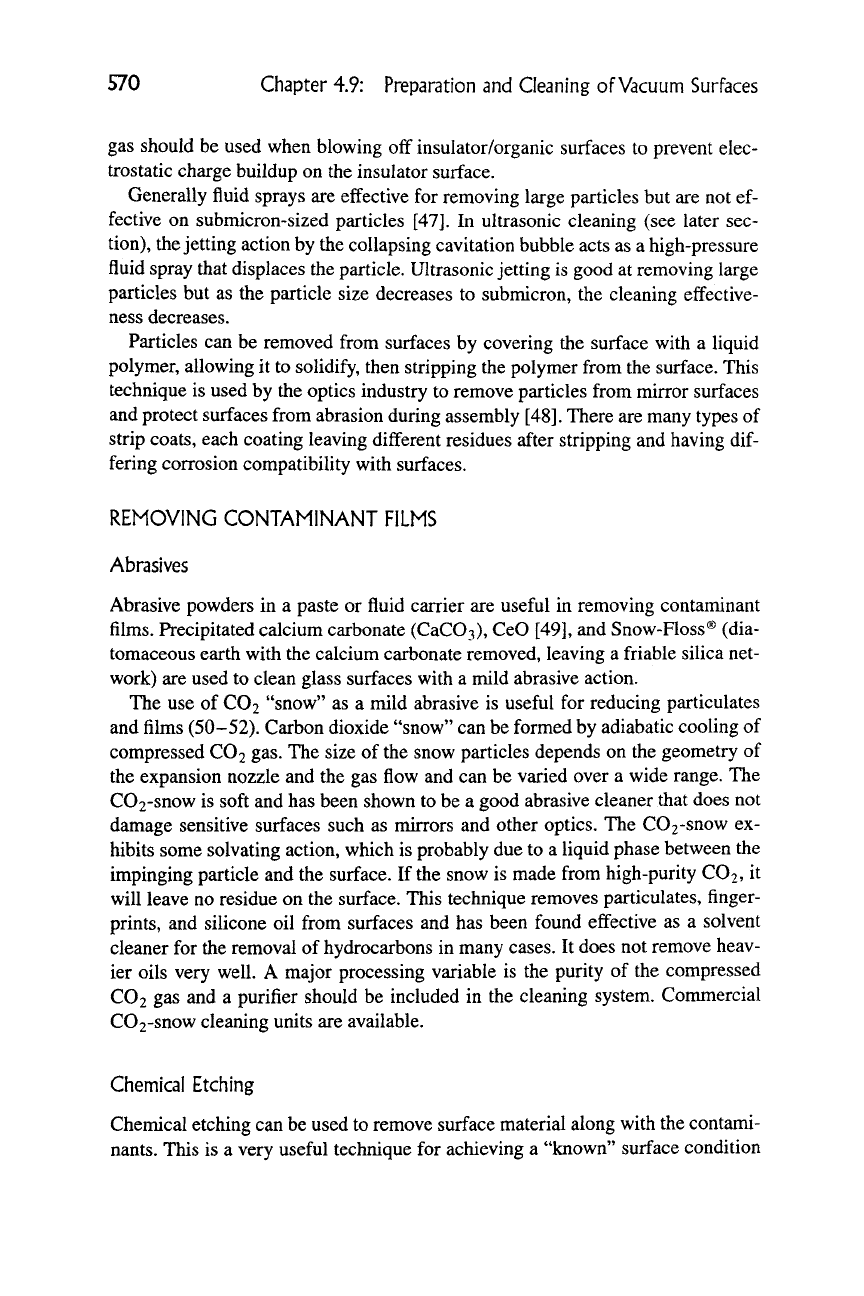
570 Chapter 4.9: Preparation and Cleaning of Vacuum Surfaces
gas should be used when blowing off insulator/organic surfaces to prevent elec-
trostatic charge buildup on the insulator surface.
Generally fluid sprays are effective for removing large particles but are not ef-
fective on submicron-sized particles [47]. In ultrasonic cleaning (see later sec-
tion),
the
jetting action by the collapsing cavitation bubble acts as a high-pressure
fluid spray that displaces the particle. Ultrasonic jetting is good at removing large
particles but as the particle size decreases to submicron, the cleaning effective-
ness decreases.
Particles can be removed from surfaces by covering the surface with a liquid
polymer, allowing it to solidify, then stripping the polymer from the surface. This
technique is used by the optics industry to remove particles from mirror surfaces
and protect surfaces from abrasion during assembly
[48].
There are many types of
strip coats, each coating leaving different residues after stripping and having
dif-
fering corrosion compatibility with surfaces.
REMOVING CONTAMINANT FILMS
Abrasives
Abrasive powders in a paste or fluid carrier are useful in removing contaminant
films. Precipitated calcium carbonate (CaCO^), CeO [49], and Snow-Floss® (dia-
tomaceous earth with the calcium carbonate removed, leaving a friable silica net-
work) are used to clean glass surfaces with a mild abrasive action.
The use of CO2 "snow" as a mild abrasive is useful for reducing particulates
and films (50-52). Carbon dioxide "snow" can be formed by adiabatic cooling of
compressed CO2 gas. The size of the snow particles depends on the geometry of
the expansion nozzle and the gas flow and can be varied over a wide range. The
C02-snow is soft and has been shown to be a good abrasive cleaner that does not
damage sensitive surfaces such as mirrors and other optics. The C02-snow ex-
hibits some solvating action, which is probably due to a liquid phase between the
impinging particle and the surface. If the snow is made from high-purity CO2, it
will leave no residue on the surface. This technique removes particulates, finger-
prints,
and silicone oil from surfaces and has been found effective as a solvent
cleaner for the removal of hydrocarbons in many cases. It does not remove heav-
ier oils very well. A major processing variable is the purity of the compressed
CO2 gas and a purifier should be included in the cleaning system. Commercial
C02-snow cleaning units are available.
Chemical Etching
Chemical etching can be used to remove surface material along with the contami-
nants.
This is a very useful technique for achieving a "known" surface condition
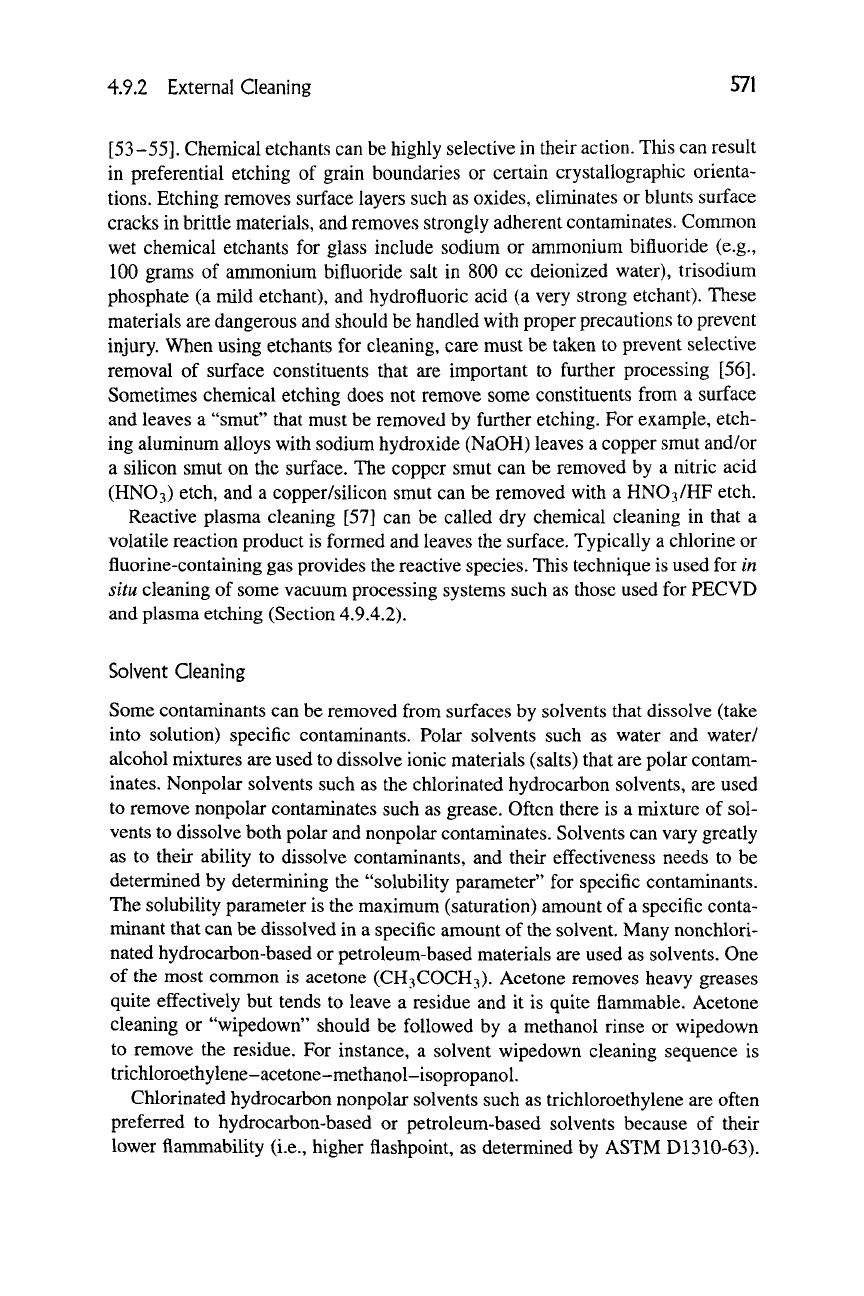
4.9.2 External Cleaning 571
[53-55].
Chemical etchants can be highly selective in their action. This can result
in preferential etching of grain boundaries or certain crystallographic orienta-
tions.
Etching removes surface layers such as oxides, eUminates or blunts surface
cracks in brittle materials, and removes strongly adherent contaminates. Common
wet chemical etchants for glass include sodium or ammonium bifluoride (e.g.,
100 grams of ammonium bifluoride salt in 800 cc deionized water), trisodium
phosphate (a mild etchant), and hydrofluoric acid (a very strong etchant). These
materials are dangerous and should be handled with proper precautions to prevent
injury. When using etchants for cleaning, care must be taken to prevent selective
removal of surface constituents that are important to further processing [56].
Sometimes chemical etching does not remove some constituents from a surface
and leaves a "smut" that must be removed by further etching. For example, etch-
ing aluminum alloys with sodium hydroxide (NaOH) leaves a copper smut and/or
a silicon smut on the surface. The copper smut can be removed by a nitric acid
(HNO3) etch, and a copper/silicon smut can be removed with a HNO3/HF etch.
Reactive plasma cleaning [57] can be called dry chemical cleaning in that a
volatile reaction product is formed and leaves the surface. Typically a chlorine or
fluorine-containing gas provides the reactive species. This technique is used for in
situ cleaning of some vacuum processing systems such as those used for PECVD
and plasma etching (Section 4.9.4.2).
Solvent Cleaning
Some contaminants can be removed from surfaces by solvents that dissolve (take
into solution) specific contaminants. Polar solvents such as water and water/
alcohol mixtures are used to dissolve ionic materials (salts) that are polar contam-
inates.
Nonpolar solvents such as the chlorinated hydrocarbon solvents, are used
to remove nonpolar contaminates such as grease. Often there is a mixture of sol-
vents to dissolve both polar and nonpolar contaminates. Solvents can vary greatly
as to their ability to dissolve contaminants, and their effectiveness needs to be
determined by determining the "solubility parameter" for specific contaminants.
The solubility parameter is the maximum (saturation) amount of a specific conta-
minant that can be dissolved in a specific amount of the solvent. Many nonchlori-
nated hydrocarbon-based or petroleum-based materials are used as solvents. One
of the most common is acetone (CH3COCH3). Acetone removes heavy greases
quite effectively but tends to leave a residue and it is quite flammable. Acetone
cleaning or "wipedown" should be followed by a methanol rinse or wipedown
to remove the residue. For instance, a solvent wipedown cleaning sequence is
trichloroethylene-acetone-methanol-isopropanol.
Chlorinated hydrocarbon nonpolar solvents such as trichloroethylene are often
preferred to hydrocarbon-based or petroleum-based solvents because of their
lower flanmiability (i.e., higher flashpoint, as determined by ASTM D1310-63).
